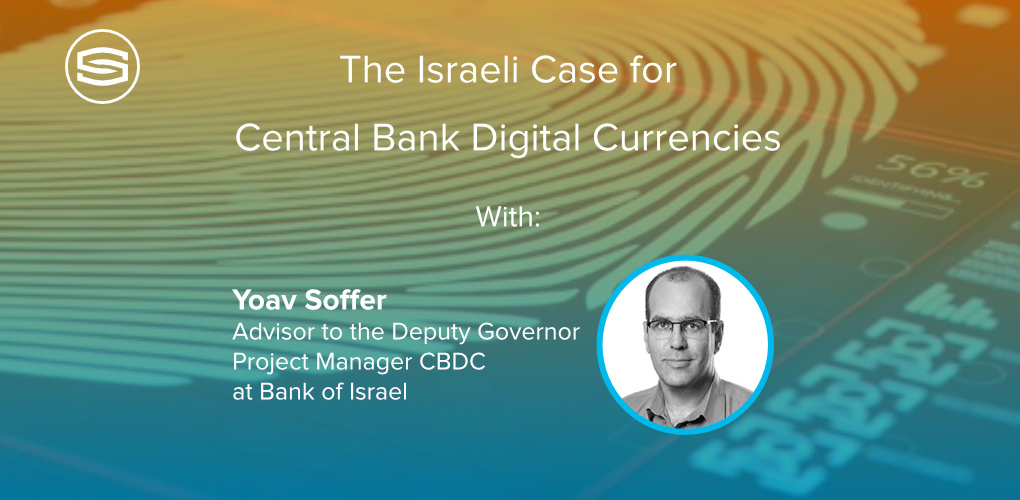
Insights & Opinions
The Israeli Case for Central Bank Digital Currencies
Tue, 20 Jun 2023


"We identified six main motivations and a series of secondary motivations to potentially issue a Central Bank Digital Currency (CBDC) in Israel. I think neither of those (individual) six could move us from not issuing a CBDC to deciding to issue it. But all of them together may pose the critical mass."
Yoav Soffer is Advisor to the Deputy Governor and Project Manager of CBDC at the Bank of Israel. I virtually met Yoav first in 2021 at Luxembourg's most prominent tech event ICT Spring. I was that day's Chairman, on location, and Yoav called in with his colleague Oded Salomy to share their learnings on CBDC.
Last week I learned the presentation resulted from the first report they issued based on a half-year research to introduce CBDC to the Israeli financial community. Today, the Bank of Israel keeps playing a prominent role and actively participates in several projects, like the ones coordinated and initiated by BIS.
Their mantra is: "We're not trying to reinvent the wheel completely by ourselves, although we want to make sure that as we design it, the potential future digital shekel is aligned as much as possible to the needs and the circumstances of the Israeli economy and specifically the Israeli payment ecosystem."
Motivations for Issuing a CBDC
"Our postcards are turning into emails; our maps are turning into GPS devices. And everything physical that can turn to digital will eventually probably turn digital", Yoav shared. "Therefore, as currently the only form of central bank money available to the public is physical cash, we risk coming to a situation where there will be no Central Bank money in the economy".
"Maybe that's okay; maybe it's okay to completely privatise the service of money and move it completely to the financial sector. But if we think there is still a role for Central Bank money in the economy, it means that at some point in time, we will need to issue a CBDC".
Innovation, Competition, Resilience, Efficiency
This post started with Yoav saying his team detected 6 main motivations, of which 3 are the more obvious ones: a Central Bank has a societal role in stimulating innovation and competitiveness in the payments industry, ensuring a resilient and efficient service for all, including in the cross-border space.
Today, Central Banks ensure innovation, efficiency and an alternative for electronic payments with regulatory measures and by providing and issuing Central Bank money in the form of cash. In a post-cash era, CBDC could be a solution for Central Banks to keep influencing the payments market at the services of people and society.
In the context of more efficient cross-border transactions, the Bank of Israel experimented in project Icebreaker with the Central Banks of Sweden and Norway on how Hash Timelock Contracts (HTLCs) could allow for near-atomic exchanges through a central hub, which removed almost completely the counterparty and credit risk with minimum adaptations requirements for the domestic systems. Project Icebreaker shows that CBDCs may provide a more competitive foreign exchange market in the future.
Privacy
Privacy was argument 4. In today's digital world, every transaction, message or step in the process is logged and documented. Some people prefer some of their services to be completely anonymous. In a world without cash, people may still occasionally like to have anonymous payments, and if these payments are for legitimate transactions, their right to do that should be maintained.
"If we are issuing a CBDC, we need to rethink the concept of privacy. The ECB has stated that it may be possible to allow offline payments to be anonymous up to a certain level, of course, which would mitigate the AML risk. This [concept] is quite innovative thinking."
Yoav continued with argument 5, combating the illicit economy, on which he said: "The idea is that maybe we could cater to those parts of the economy that still prefer to use of cash, not because they don't want to pay taxes, but because maybe they have some cultural contexts that prevent them from using digital means of payments."
What was interesting is that before working full-time on CBDC, Yoav coordinated the work of an inter-governmental team on financial inclusion. He explained that around 20% of Israel's population is Arab. Although around 85% of that population has a bank account, only 50% use a debit or credit card for their payments. Instead, they prefer to withdraw the money from their account on the first of the month and use it to pay cash.
Yoav believes that with a well-designed CBDC, perhaps it would be possible to overcome the distrust in the government or financial system and the cultural or even religious barriers to using cards.
For example, another some 15% of the Israeli population is Jewish Orthodox, and many of them refrain from using smartphones for religious reasons. If you design it in a way that other kinds of devices can take over, like smart cards, bracelets or anything else, a CBDC could bridge the existing financial exclusion and create an ecosystem for digital payments without tax evasion, that may even allow a higher level of privacy than that you have in digital payments today.
Reducing tax evasion
That latter was motivation number six: to allow the public to continue to be able to pay for some of their trnasactions while maintaining a level of privacy, or even partial anonymity, that would not contradict AML laws and tax rules.
On the question of whether commercial banks can't build a solution to answer these motivations, Yoav's feedback was: "The case for CBDC will indeed also depend on the answer to the following question: Where does the public sector want to be the provider of a good, and where does the public sector want to be the regulator of how the market provides the good? I sense that there's a place for both".
For example, what happens if it is not economic for the private sector to serve some segments of society, or that not all parts of the economy are exposed to a competitive ecosystem? He believes that is where the Central Bank should help and solve market frictions where needed.
Is CBDC a geopolitical game?
CBDCs became a thing when Facebook launched its Libra project, later called Diem. The fear was that this private currency could take over the world by storm, given the massive network of users the social network has.
At the same time, a lot was said about China that wanted to exploit its e-Yuan to decrease the value and power of the dollar in international trade. It was told by some to be a political weapon.
I kind of believed that as well. Thanks to this talk with Yoav, this became a sentence in the past tense.
Yoav demystified: "I think the public debate on this issue is misinformed to a great extent. If you put a limit of 3,000 euros on a consumer's holding, that device will not become a device holding reserves. These are not the numbers to build a reserve in global trade. If the digital euro will be limited to 3,000, or even 30,000 euros per holder, this means that at least the digital euro will not become a reserve mechanism."
First and foremost, at least for the retail CBDC, the currency must serve the people, which is also why most Central Banks look at the two-tier system with an intermediary between the consumer and Central Bank. Europe is looking at existing banks and PSPs to be that intermediary. Israel is leaving more options open and is currently investigating even more options in Project Sela. Together with BIS and the Hong Kong Monetary Authority, they are analysing the option of having even a supermarket, or an airline, for example, be able to provide the digital shekel wallet.
In other words: retail CBDC is highly local and has very little impacting the geopolitical game.
Will CBDC be Distributed-Ledger-Technology-based?
As a pragmatic economist by training, Yoav was very clear on whether CBDC will be based on DLT: "We have started focusing on designing the business kind of characteristics of what may be the Israeli CBDC. And eventually, we will tell the public and the ecosystem and ourselves what we want our services to be able to do."
And so, at this moment, he doesn't know. On the other hand, he is convinced that Central Banks will not risk having their digital money on a public, non-permissioned blockchain. Of course, that still leaves an endless set of possibilities.
Yoav: "I think that there could be some ideas and kinds of concepts that come from the distributed ledger technologies into the design of CBDCs. Would you call them blockchains or DLT at the end of the road? Maybe, maybe not. And maybe it's not that important; maybe what's important is what we want to achieve and which technology can achieve that."
Conclusion
I am not going to lie, this is one, and maybe the most, interesting CBDC conversation I’d ever been in and I really appreciate Yoav’s openness in explaining CBDC and in putting it in the right context. As he explained you first need to get your requirements sharp before talking about the technology to implement.
With every talk, these requirements will get sharper and I look forward to see what this will end and how we will be paying in 5-10 year.
P.S.: if you like more, make sure to attend our session on June 29, 2023: Decoding EC's Game-Changing Payments Announcements of June 28.
P.P.S.: on September 14, we organise The Banking Scene Payments BBQ Night on the Future of Money.